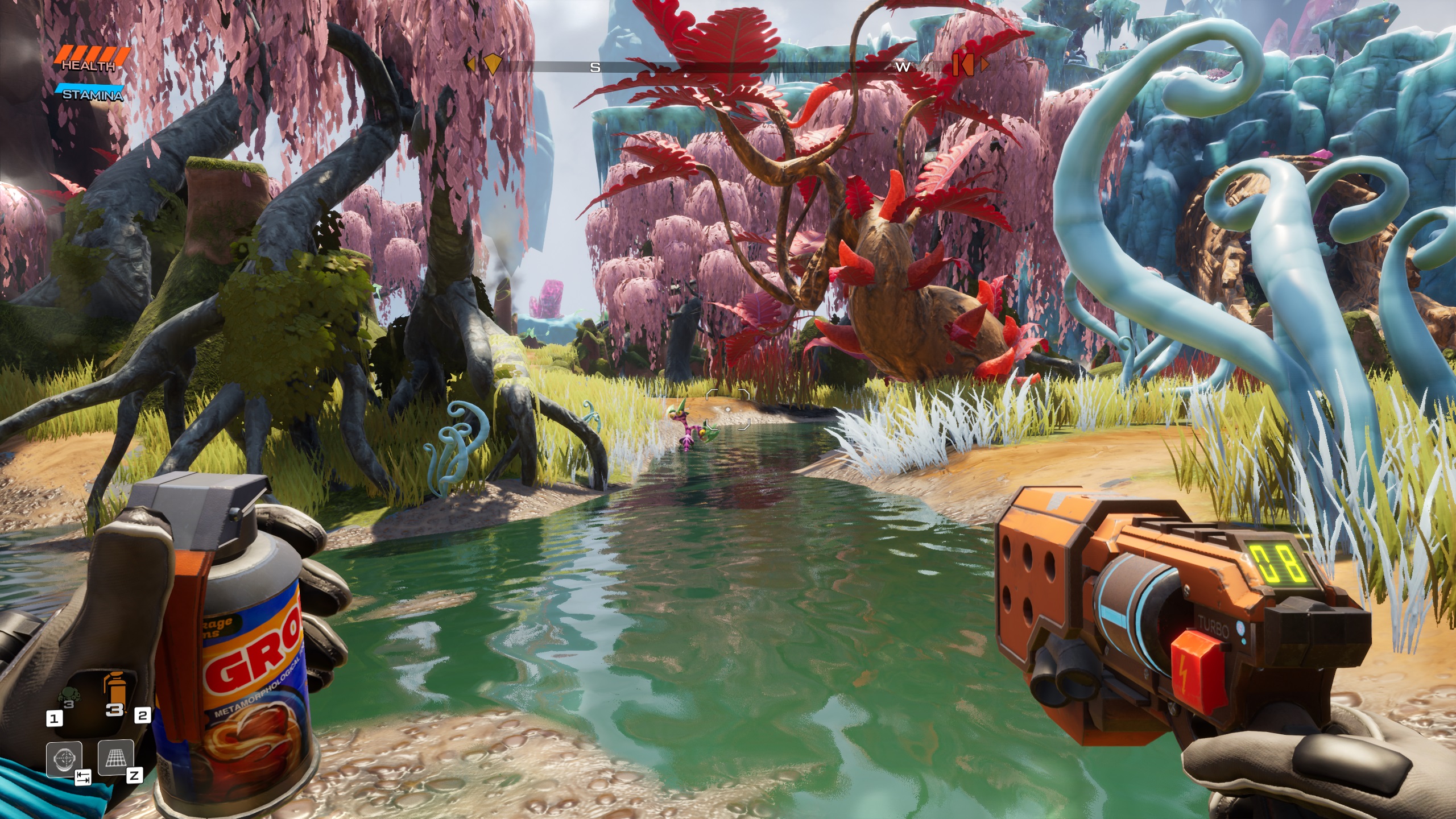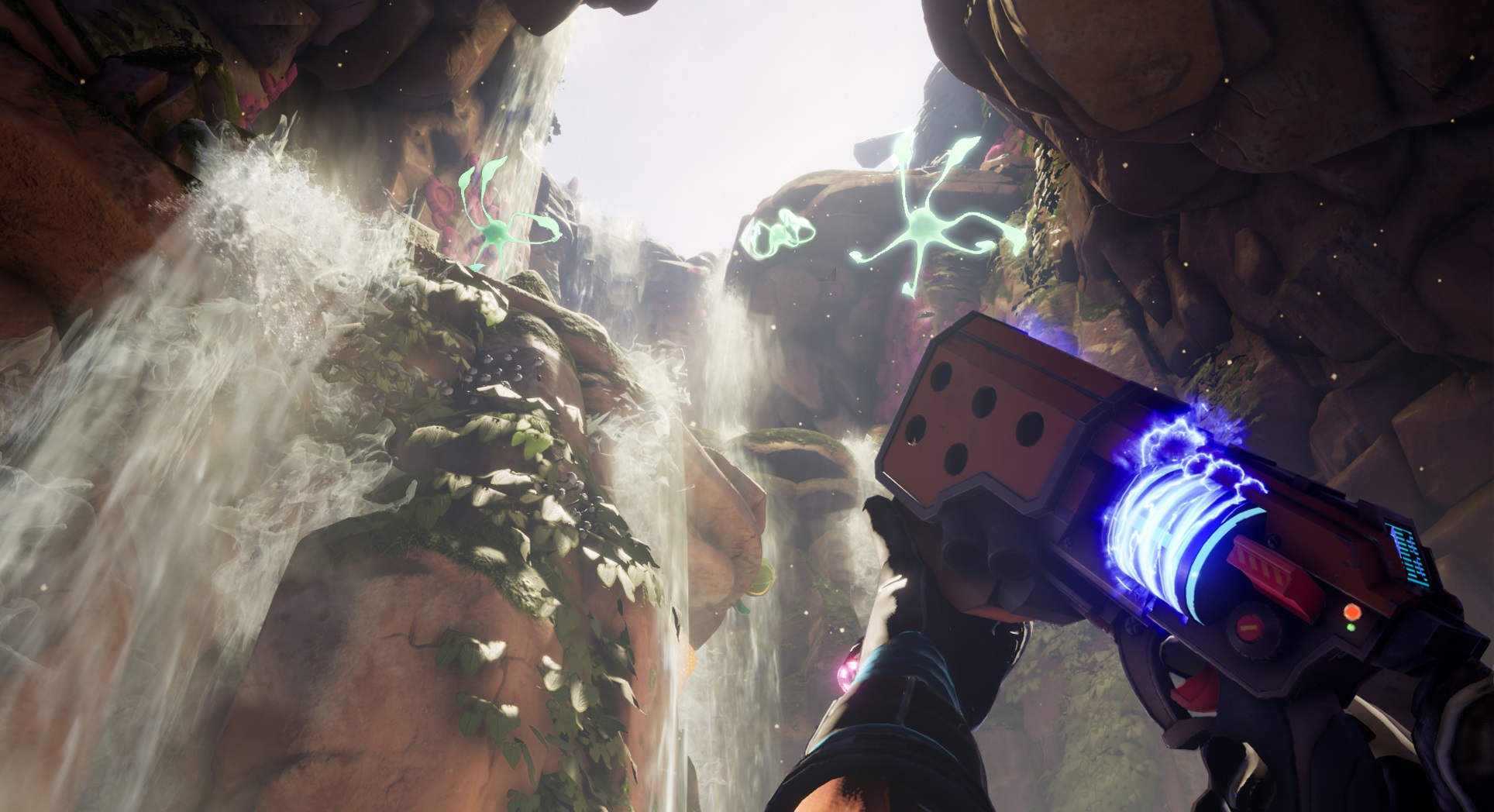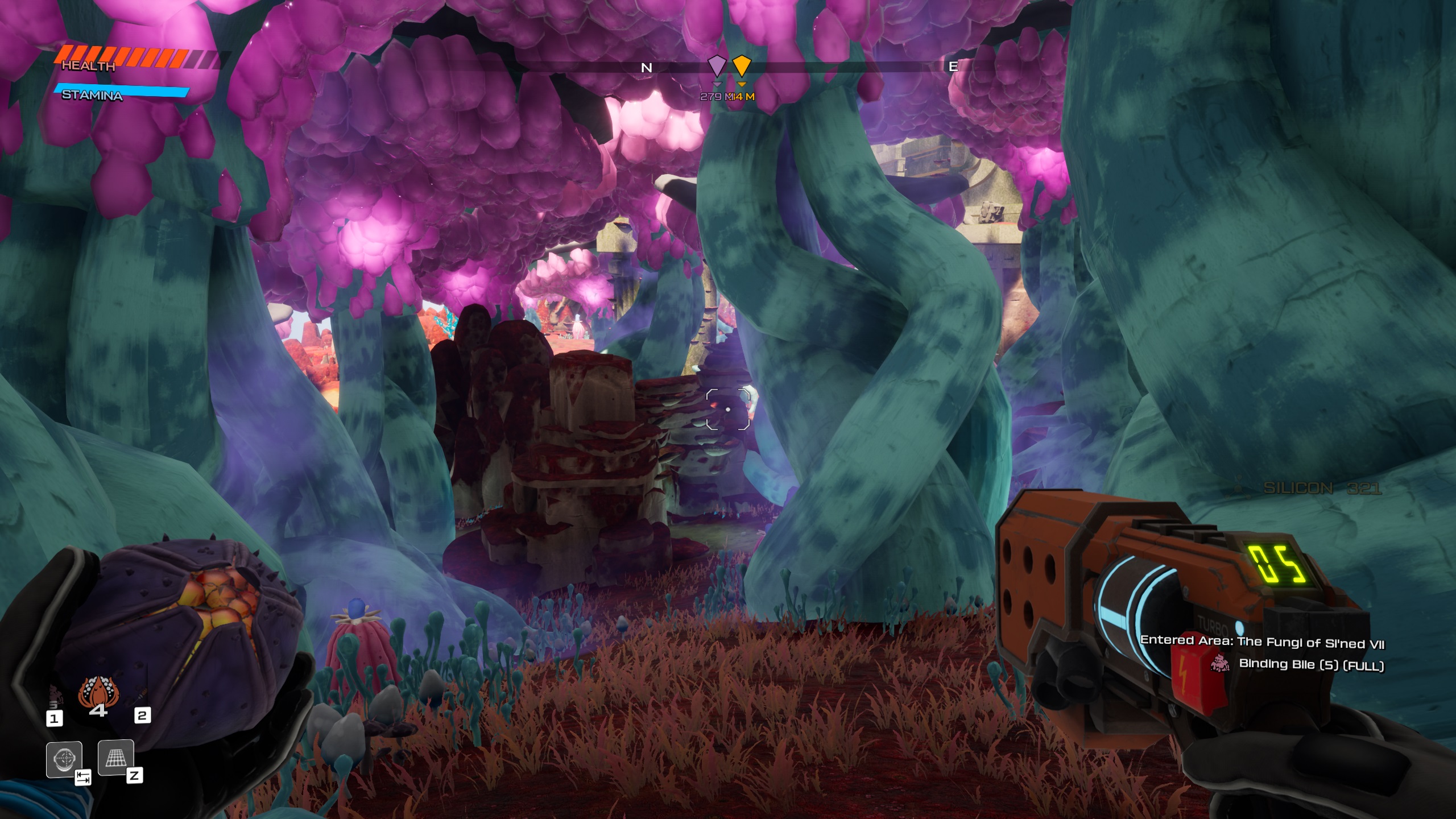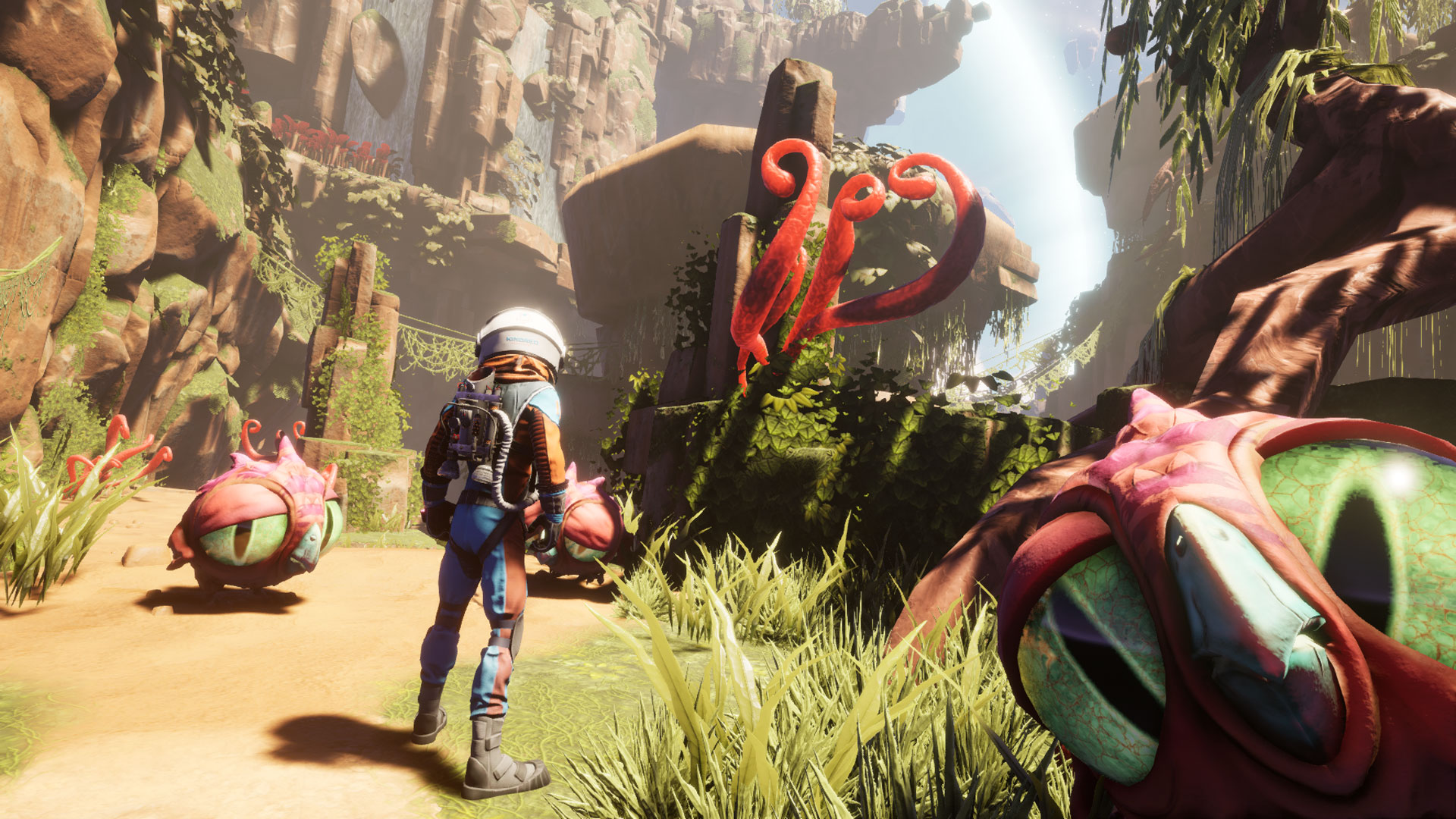GamesRadar+ Verdict
A short and satisfying space adventure which really is laugh out loud funny
Pros
- +
Gorgeous environments
- +
Spot-on humor
- +
Painfully relevant satire
Cons
- -
Slightly clunky controls
- -
Some obtuse objectives and markers
Why you can trust GamesRadar+

Release date: January 28, 2020
Platform(s): PC, PS4, Xbox One
Developer: Typhoon Studios
Publisher: 505 Games
Journey to the Savage Planet is a unicorn in this day and age. It's a short game that's totally satisfying, and it's a comedy game that's actually funny. And if that wasn't enough, it also has a crafting system that isn't tedious. It caught me totally off-guard the first time that I got my hands on it, and it continued to surprise me throughout its six-hour runtime – so much so that I'm eager to play more of it for post-game exploration, and maybe again in co-op too.
Journey to the Savage Planet tips
As a new member of Kindred Aerospace's Pioneer Program, you're sent to the alien planet AR-Y 26 to scout it out, see if it's habitable, and shake it down for resources if it's not. It quickly becomes clear that this planet is a bit more than you bargained for – savage, you might call it – and that your employer isn't terribly concerned for your safety. So begins an irreverent tale of capitalism and climate change which is every bit as scathing as it is satirical.
Journey to the Savage Planet is a first-person action-platformer about collecting resources, crafting upgrades, using them to explore the titular planet, and shooting various critters which get in your way. Just as importantly, it's a blunt and relentless caricature. It's set in a time when Earth has officially kicked the bucket due to climate collapse, forcing humanity to find a new home among the stars. Naturally, blatantly evil corporations – not unlike Kindred Aerospace – are trying to monopolize the galaxy and monetize free will.

Messages and expository snippets constantly remind you of the state of the galaxy and your meager place in it. You, the player, are around $500,000 in debt, but you can halve that by simply selling the rights to your brain. Your contract with Kindred Aerospace ensures that you'll be continually resurrected until your job is done – in other words, not even death can free you from the grip of debtors. At one point, I was advised to read the book, "Just Be Rich Instead of Being Poor." Many key upgrade materials look like oil, and since this is technically foreign territory, I can only assume that war under the guise of democracy is on the way.
This is the kind of exaggerated corporate hellscape as depicted in works like Wall-E and The Outer Worlds, and it's grounded in such a way that it's sometimes hard to laugh it off. Topical descriptions of the Amazon Rainforest and the Great Barrier Reef – both totally annihilated in the game, and at risk of a similar fate in real life – are especially harrowing, but this is all just a grim backdrop to the game's surprisingly chipper presentation. And it is nice to see a game actually say something about the serious topics it's skewering without getting bogged down with negativity.
Cute new world

More than anything, Journey to the Savage Planet reminds me of Rare circa Conker's Bad Fur Day. It's bright, cute, colorful, and endlessly charming. AR-Y 26 is filled with adorably boggle-eyed creatures as well as ferocious predators, and there's a dark silliness to it all that plays into its Dr. Seuss aesthetic perfectly. The best part is that every last element serves as a comedic vehicle. This gives the game a Far Cry 3: Blood Dragon quality where I feel compelled to find more creature descriptions and lore entries just to see what they say, because it's usually hilarious.
Speaking of creature descriptions: your main method of cataloging the planet's flora and fauna is a Metroid Prime-style scanner, and this quickly became one of my favorite features in Journey to the Savage Planet. Sure, scanning enemies and puzzle pieces gave me helpful hints, but I was mainly in it for the laughs. My first entry was for a Pufferbird which, as my sardonic, Glados-esque AI overseer informed me, totally loves me. I was picking up what this game was putting down by this point, so I knew I was going to be doing terrible things to this Pufferbird in the near future, so I apologized in advance. Sure enough, not 10 minutes later, I lured it into what I can only describe as a venus flytrap wood chipper so that I could open a door. I'm sorry again, Pufferbird.
"Journey to the Savage Planet is bright, cute, colorful, and endlessly charming"
Some creatures aren't as naive as Pufferbirds and require a more forceful touch, which brings us to the game's simple but serviceable action. Your main weapon is a laser pistol with infinite ammo (but a limited magazine), and you've also got a grappling hook and jetpack to get around, as well as consumables which fuel an array of gadgets I won't spoil. You can dash to avoid incoming enemies or projectiles, slide under and into gaps, and mantle up ledges. It's not Mirror's Edge or Apex Legends, but Journey to the Savage Planet is fun to play moment-to-moment. I was especially impressed by the game's boss battles, which are far more difficult and memorable than I expected them to be. The controls are a bit clunky at times, with slide stutter and dodgy grapple registration in particular leading to more than a few mishaps, but there are no deal-breakers. Besides, this is a game where combat and movement improve as you unlock more and more upgrades that expand your abilities.
You can upgrade gadgets by finding Metroidvania-style upgrades which unlock new areas, and by juicing them up with resources. There are only three main resources – carbon, silicon, and aluminum – which keeps things clean and straightforward. Journey to the Savage Planet is not a crafting survival game. It's not Ark or No Man's Sky; you don't have to smelt any iron or grind any materials. I put together a respectable arsenal just by snagging whatever I saw on the way. Resources exist simply to encourage you to explore, and upgrades let you flesh out your play style in mostly optional ways. They also encourage you to experiment, which works well with the game's not-quite-linear path.
The path less travelled

Early in the game, my AI told me to find an alien alloy that I could use to make a crucial upgrade. The target alloy was marked on my compass, but wanderlust set in on the way there and I ended up finding another alloy much closer to my crashed ship. In many games, I would've needed to get the marked alloy anyway because it's what the story calls for. Instead, my AI was like, "Oh, you found a different one, I guess that works too!"
This was a small interaction, but it taught me that I could do things out of order if I wanted to, and it reinforced that exploration pays off. This shaped the way I played the rest of Journey to the Savage Planet, and while the path forward was still mostly linear, I enjoyed branching off to test the limits of my gadgets and chart my own course. It made my journey feel more personal, especially when I was able to access some things early through clever tactics. In my finest moment, I used deployable bounce pads, gravity, and meticulously timed jumps to access a secret locked behind an upgrade I hadn't discovered, and the sense of triumph was palpable. I would've liked a few more of those freeform moments, but the journey felt well-paced overall.
It's also worth noting that while I finished the game in just over six hours, that was only with 67% completion. I'm the kind of person who generally blasts through story stuff in open-world games, so I've still got dozens of upgrades and secrets left to find which could easily push Journey to the Savage Planet over the 10-hour mark. That said, don't be put off by the length. This game doesn't need to be any longer, and given the wealth of time vampires on the market, I respect and welcome a good short game. There's more here than you need, so you can play Journey to the Savage Planet precisely as much as you want. And in my experience, you'll have a great time no matter what you do.
Journey to the Savage Planet was reviewed on PC

Austin has been a game journalist for 12 years, having freelanced for the likes of PC Gamer, Eurogamer, IGN, Sports Illustrated, and more while finishing his journalism degree. He's been with GamesRadar+ since 2019. They've yet to realize his position is a cover for his career-spanning Destiny column, and he's kept the ruse going with a lot of news and the occasional feature, all while playing as many roguelikes as possible.



